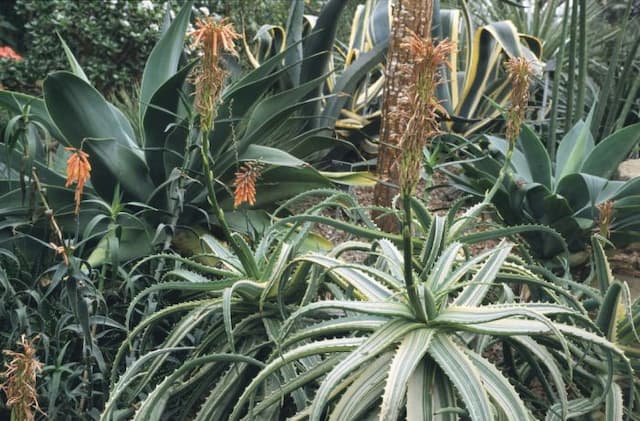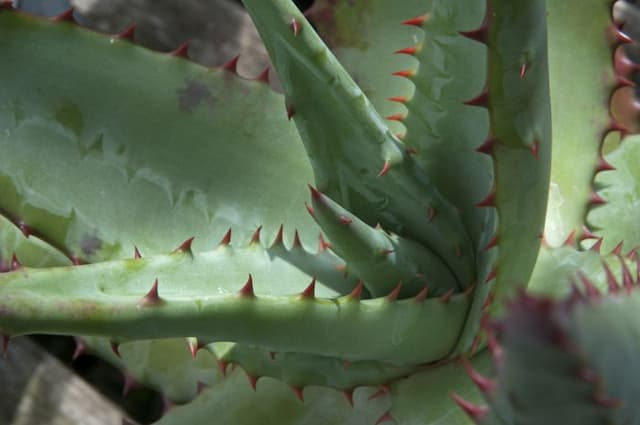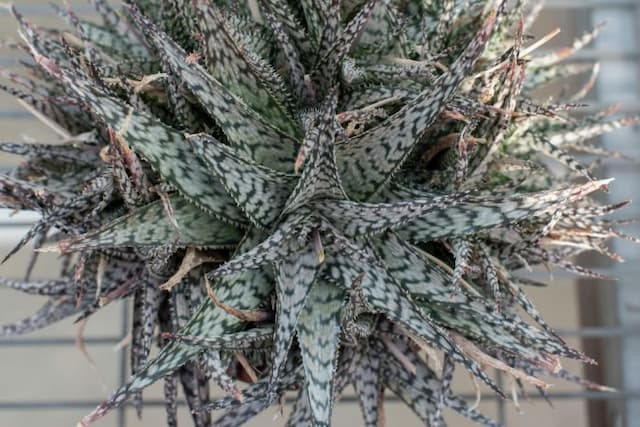Red hot poker Kniphofia Bressingham Sunbeam = 'Bresun'
![red-hot poker [Bressingham Sunbeam]](/_next/image?url=https%3A%2F%2Fplants-admin.emdemapps.com%2Fimages%2Fplants%2F%2Fimages%2F604b575c507b2.png&w=3840&q=75)
ABOUT
Kniphofia Bressingham Sunbeam, commonly known as Red Hot Poker or Torch Lily, is distinguished by its striking flower spikes. The blooms on this plant progress from a warm, creamy yellow at the base, slowly transitioning to a vibrant orange at the tip, creating a two-toned effect that resembles a flickering flame. The flowers are densely packed on the tall spikes which rise above the foliage. The leaves form a grassy, clump-like base with a linear and slightly arching shape, offering a lush green backdrop to the vivid flower display. The overall appearance of this plant is that of an eye-catching, vertical element in the garden thanks to its showy floral spikes.
About this plant
 Names
NamesFamily
Asphodelaceae
Synonyms
Red Hot Poker, Torch Lily, Tritoma
Common names
Kniphofia 'Bressingham Sunbeam' = 'Bresun'.
 Toxicity
ToxicityTo humans
Red hot poker, the common name for Kniphofia Bressingham Sunbeam, is not typically known to be toxic to humans. However, it is always recommended to be cautious and avoid ingesting plants that are not commonly used as food, as individuals may have varying sensitivities or allergic reactions. There is no well-documented toxicity or specific symptoms associated with ingesting this plant, but consuming non-food plants can potentially cause gastrointestinal discomfort or other forms of irritation.
To pets
Red hot poker, the common name for Kniphofia Bressingham Sunbeam, is not widely recognized as a toxic plant to pets. While it is not known for possessing any toxic compounds that would cause serious harm if ingested, pets should still be discouraged from eating ornamental plants. Ingestion of non-edible plants can cause mild gastrointestinal upset, such as vomiting or diarrhea, in some animals due to the unfamiliar material or potential mechanical irritation. If you suspect your pet has ingested a large amount of the plant and is showing symptoms of distress, it is advisable to consult a veterinarian.
 Characteristics
CharacteristicsLife cycle
Perennials
Foliage type
Evergreen
Color of leaves
Green
Flower color
Yellow
Height
2-3 feet (60-90 cm)
Spread
1-2 feet (30-60 cm)
Plant type
Herb
Hardiness zones
6
Native area
Africa
Benefits
 General Benefits
General Benefits- Attracts pollinators: 'Bresun' is known to attract bees, butterflies, and other beneficial insects, which help pollinate other plants in the garden.
- Drought-tolerant: Once established, it has low water requirements, making it ideal for xeriscaping or drought-prone areas.
- Visual interest: With its vivid, torch-like flower spikes and grassy foliage, it adds unique texture and color contrast to garden designs.
- Long blooming period: It has a long flowering season, which provides color in the garden for an extended time.
- Low maintenance: Requires minimal care once established, with little need for pruning or deadheading.
- Deer resistant: Typically not favored by deer, making it a good choice for gardens in areas with a high deer population.
- Versatile: Can be used in a variety of garden styles including borders, rock gardens, and as a focal point in mixed beds.
 Medical Properties
Medical PropertiesThis plant is not used for medical purposes.
 Air-purifying Qualities
Air-purifying QualitiesThis plant is not specifically known for air purifying qualities.
 Other Uses
Other Uses- **Textile Dyeing**: The vibrant colors of Red Hot Poker flowers can be used to create natural dyes for fabric, giving textiles a unique and eco-friendly coloration.
- **Photography Subjects**: Due to their striking appearance, Red Hot Pokers can be the focus of botanical photography, lending their vivid colors and structural forms to create stunning images.
- **Artistic Inspiration**: Artists may use Red Hot Poker plants as a muse for paintings, drawings, or sculptures, capturing their fiery hues and bold shapes in various artistic media.
- **Education**: These plants can be used in educational settings to teach about pollination as they attract hummingbirds, bees, and butterflies which are excellent examples of pollinators.
- **Thermal Insulation Material**: The fibrous leaves of the Red Hot Poker, when dried, could potentially be used as a natural insulation material for small-scale projects.
- **Floral Arrangements**: Red Hot Pokers make dramatic additions to bouquets and floral arrangements, adding height and a burst of color.
- **Garden Design**: With their vertical silhouette, Red Hot Pokers can be used to create focal points in garden design, guiding sight lines and structuring plant beds.
- **Culinary Garnish**: Though not widely known for this use, the flowers could serve as an ornamental garnish for dishes, provided they are free of pesticides and confirmed non-toxic.
- **Candle Making**: The unique structure of Red Hot Poker flowers can inspire the design of decorative candles and holders, mimicking their torch-like appearance.
- **Craft Projects**: Dried Red Hot Poker flowers can be incorporated into craft projects, like making bookmarks or adding to homemade potpourri for an unusual visual element.
Interesting Facts
 Feng Shui
Feng ShuiRed hot poker is not used in Feng Shui practice.
 Zodiac Sign Compitability
Zodiac Sign CompitabilityRed hot poker is not used in astrology practice.
 Plant Symbolism
Plant Symbolism- Standout Appearance: The vibrant, torch-like flowers of the Kniphofia 'Bresun', commonly known as Red Hot Poker, symbolize a bold or flashy presence due to their striking and unusual flower spikes.
- Attraction & Vibrancy: The bright hues of Red Hot Poker flowers signify attraction and brightness in life, adding color and vibrancy wherever they are planted.
- Strength & Resilience: As a hardy perennial capable of withstanding challenging conditions, the Red Hot Poker represents strength, resilience, and the ability to endure harsh environments.
 Water
WaterWater the Red Hot Poker plant deeply once a week during its growing season, ensuring that the soil is kept consistently moist, but not soggy. During periods of high heat or extended drought, increase watering frequency to twice a week. Each watering session should involve applying approximately one to two gallons of water, depending on the size and maturity of the plant. During the winter, when the plant is dormant, reduce the frequency to every few weeks, ensuring that the soil does not dry out completely. Adjust the watering schedule according to regional climate, soil type, and seasonal weather variations.
 Light
LightRed Hot Poker plants thrive in full sunlight, requiring at least six hours of direct sunlight per day. Find a spot in your garden that receives unobstructed sunlight for the majority of the day. Dappled afternoon shade can be beneficial in extremely hot climates, but overall, these plants perform best when they're soaking up plenty of sunshine.
 Temperature
TemperatureRed Hot Poker plants are hardy and can withstand temperatures as low as 0 degrees Fahrenheit, making them suitable for many climates. However, they grow best when the temperature ranges between 50 and 90 degrees Fahrenheit. They can tolerate occasional extremes outside of this range but prolonged exposure to temperatures below freezing or above 90 degrees Fahrenheit can stress the plant.
 Pruning
PruningPrune Red Hot Poker plants by removing spent flower spikes to encourage new blooms and to maintain a tidy appearance. In late fall or early spring, cut back the foliage to about 3 inches above ground level to remove any dead leaves and promote fresh growth. Pruning should be carried out annually or as required when the plant starts looking unkempt.
 Cleaning
CleaningAs needed
 Soil
SoilRed Hot Poker 'Bresun' thrives best in well-drained soil with a loamy or sandy texture, mixed with compost for fertility. Its ideal soil pH ranges from 6.0 to 6.5, slightly acidic to neutral. To create the best soil mix for 'Bresun', combine two parts loam with one part sand and one part compost or well-rotted manure.
 Repotting
RepottingRed Hot Poker 'Bresun' doesn't require frequent repotting, and it's actually best to disturb the plant as little as possible. Repotting might be necessary every 3-5 years if it outgrows its container or if the soil becomes too compacted.
 Humidity & Misting
Humidity & MistingRed Hot Poker 'Bresun' is tolerant of various humidity conditions and does not require a specific humidity level to thrive. However, they prefer conditions that mimic their natural dry grassland habitat and are quite resilient to dry air.
 Suitable locations
Suitable locationsIndoor
Ensure full sun and good airflow for indoor Red Hot Poker 'Bresun'.
Outdoor
Plant in full sun with good drainage for outdoor Red Hot Poker 'Bresun'.
Hardiness zone
6-9 USDA
 Life cycle
Life cycleThe life of the Red Hot Poker 'Bressingham Sunbeam' ('Bresun') begins with seed germination, typically occurring in well-draining soil and with adequate warmth and moisture. Following germination, the seedling stage is characterized by the growth of basal foliage that forms a grass-like clump. As the plant matures, vegetative growth continues with the development of long, strap-shaped leaves. The flowering stage is marked by the emergence of tall, stout flower spikes bearing tubular flowers that can range from yellow to orange and red, attracting pollinators such as bees and hummingbirds. After pollination, the plant produces capsules containing seeds, completing the reproductive cycle. The Red Hot Poker 'Bressingham Sunbeam' then enters a period of dormancy in colder climates during winter, resuming growth in the following spring.
 Propogation
PropogationPropogation time
Spring to early summer
Red hot poker, particularly the Kniphofia 'Bressingham Sunbeam', is commonly propagated by division. The best time to do this is in the spring or early fall, when the plant is not in active bloom. To propagate by division, carefully lift the plant from the ground using a garden fork. Gently separate the clumps into smaller sections, ensuring each division has a good amount of roots and a few shoots. These divisions can then be replanted immediately, spaced approximately 18 inches (about 45 centimeters) apart to give them room to grow. Water the new plants well to help establish them. Division is a reliable and straightforward method that allows gardeners to produce new plants that are genetically identical to the parent plant.









